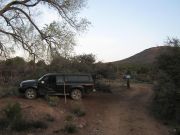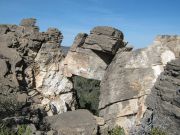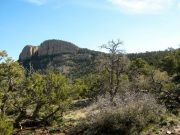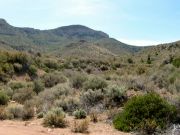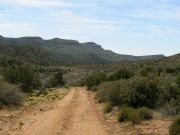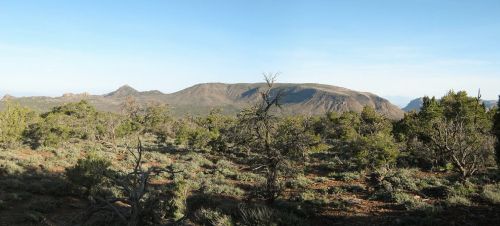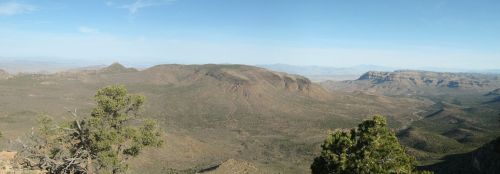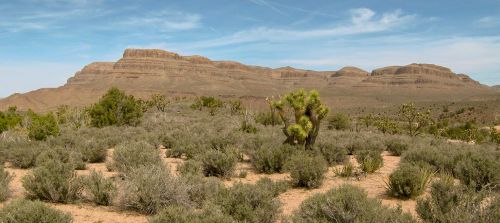
The Mountains of Arizona
• www.surgent.net
|
| Duncan Benchmark |
• Highpoint: Music Mountains • Highpoint: Grand Wash Cliffs • Mohave County, Grand Canyon West |
|
Date: April 6, 2013
• Elevation: 6,769 feet
• Prominence: 2,219 feet
• Distance: 6 miles
• Time: 4.5 hours
• Gain: 1,800 feet
• Conditions: Sunny and pleasant
The Grand Wash Cliffs extend for about 60 miles in northwest Arizona, forming a western boundary of the plateau system that hems in the Grand Canyon. Atop the plateau sits the Hualapai Indian Reservation, while west of the cliffs, the land gives way to desert valleys cut by smaller mountain ranges. The small towns of Meadview, Pierce Ferry and Dolan Springs sit within these valleys and along the shores of Lake Mead. The highest point along these cliffs and of the whole plateau is a 6,769-foot hilltop containing the Duncan Benchmark. Naturally, it's beautiful country up here, but remote. In recent years, a few more people have come to this far corner to visit the Grand Canyon Skywalk. Duncan Benchmark is about 15 miles southwest from this attraction.
This hilltop is one of the 73 peaks in Arizona with 2,000 feet of prominence, and I had been aware of this peak for many years. But its distance from home and uncertain access caused me to hold off on this peak until I had some better ideas on how to tackle this summit. The actual climbing looks easy on the map. The issue is the scant road net out here, plus some private-property inholdings and that of the Hualapai Nation. It wasn't so much how to climb it, but how to actually get there with the least amount of hassle.
There are three options to gain the top, all apparently viable since people have managed to summit this peak from these three different directions. I decided to go with the northwest approach, starting at a locale called "Ray Place" as shown on the topographical map. A road of uncertain quality leads to this place, from which the map shows friendly ridges that theoretically lead right to the top. It was worth a look.
Other options to the summit include an eastern approach via Reference Canyon and the Hualapai Nation, or a southern approach from the Music Mountains Ranch. The east approach requires a permit from the Hualapai Nation, plus very long distances on dirt road, while the south approach features a road that wiggles up to the plateau and possibly close to the top ... or possibly not. In that case, I could be looking at over 8 miles of road-walking (each way) if my truck wasn't up for the road. Thus, I chose the northwest approach, aware that the road to Ray Place is "not bad", according to a previous visitor. In the worst case, I could walk the road, which would make for a 14-mile hike. I could live with that.
I left work on Friday afternoon and headed toward Kingman. I decided to take the scenic route through Prescott and Chino Valley, catching Interstate-40 at Ash Fork. I did this partly to avoid the Friday-afternoon Phoenix-to-Vegas crowd on US-93. A couple of traffic tie-ups slowed me, but I made good time and arrived in Kingman around 4 p.m., where I shopped for groceries for the hike. While the day had been clear and warm down in Phoenix, up here it was cloudy and overcast, but mild.
From Kingman, I drove "eastbound" (northeast) on AZ-66 for about 20 miles to the Antares Road turn-off, then northwest on Antares Road, which runs below and parallel to the southern extent of the Grand Wash Cliffs. The road is hard-pack and very wide, and I was able to average 50 m.p.h. along it. Another 20 miles or so, I came to its intersection with Pierce Ferry Road. I then followed that northwest another 7 or 8 miles to Diamond Bar Ranch Road, which is the turn-off for the Grand Canyon Skywalk. The land up here is high desert, thickly forested with Joshua trees.
I drove Diamond Bar Ranch Road for 6.8 miles. The road is paved for the first 4.5 miles, then graded dirt. It was relatively busy with tourists coming and going to the Skywalk. I came to the Grand Canyon West Ranch buildings after 6 miles, then found the measly little BLM road less than a mile later. I signed in at the kiosk and got a free permit. Although most of the land is BLM, I'd be crossing through a couple private property segments. Going by the sign-in log, most people come here to hunt, but the numbers of visitors is not much.
Not sure of this road's condition, I put the truck into 4-wheel drive and inched upward. It looked ugly at first, but then improved. I came to an open gate after 0.7 mile, and slowly rumbled south along this road. Only one spot was rough enough where 4-wheel drive was mandatory. Otherwise, it was a decent, mostly-smooth road. On my left, the magnificent Grand Wash Cliffs rose like a continuous wall, while on my right was Iron Mountain, a smaller plateau-like peak that looks like it deserves a future visit.
I eventually bumped and grinded to the fence/gate/corral at Ray Place, 4.5 miles from the main road. Ray Place didn't look like much, and I didn't sense anyone actually lives there (I could be wrong). It was 6 p.m., so I started looking for a place to camp. There were no options near Ray Place, so I backtracked about a half-mile and backed into a meager spot, the best I could find amid the thick scrub and rocks. I had put on just under 300 miles since starting the drive, and I was pleased to have made it as far as Ray Place, meaning the hike itself would that much shorter.
The night was mild and still, and I poked around camp a little while. I ate some pre-packaged pork roast then made a mush out of the gravy and pop-chips, like mashed potatoes, and it was divine. The bugs weren't a problem, and I saw a few bats flitter by. However, I was beat from the long drive, and I crawled into my truck-bed and was asleep by 8:30. I was up at 5 a.m. with the sun, and after time getting my act together, I loaded up everything and drove back to the corral at Ray Place, trying to park my truck off the road and outside the Ray Place boundary. That proved to be real tricky, and I spent about 15 minutes trying things, moving rocks, until finally wedging it onto a sandy berm. I was walking at 6:20 a.m., the sun still low in the sky and me in the shade. My starting elevation was a shade over 5,000 feet.
A creekbed runs in front of the Ray Place fence, and I walked this for about a quarter mile, following cow paths. Shortly, I came to a section of big rocks, and after that, the creekbed split. I angled left, now walking up a narrower, brushier draw. Looking up, the summit stood above and to my left, fronted by an impressive wall of fluted-rock cliffs. South of the summit, the cliffs gave way to forested slopes. A sub-ridge came off the main range crest and right toward me. I could see virtually my entire route. It looked promising, but brushy. While there'd be no climbing of cliffs, I'd have to earn this summit with some hefty bush-bashing.
When it felt right, I angled left out of the creekbed and onto the banks, barging my way through waist-high scrub featuring a lot of densely-packed madrone. Some cow paths helped here and there, but mostly I had to barrel directly through the crud. Just as fast, it would end and I'd have a few minutes of lovely open-terrain walking. Then it would come back. Directly ahead of me on my sub-ridge was a small section of cliffs, but it appeared they didn't extend all the way across. After some laborious bush-whacking, I angled my way to the base of these cliffs, and sure enough, there weren't any. Instead, I dealt with simple scree slopes, which was loose and annoying, but it went fast. Within minutes, I had scampered up and over this barrier, now on a flat bench about 5,600 feet elevation.
This segment was a delight, being nearly flat with no dense undergrowth. I weaved my way through the larger brush, including copses of pinon. The terrain started to steepen, a little at first, then a lot. I was climbing toward the top of a small ridge-bump, when I should have been angling left to try and sidehill toward a saddle slightly closer to the summit. However, I was close enough to the top of this hill I just went for it. Soon, I was on its top, and now had easier, slightly more open terrain to manage as I now turned left (north), now aiming for the summit.
On this ridge, the forest was thick, but the heavy woody undergrowth was absent. I could generally see a couple hundred feet ahead of me, and in a few spots, the whole rest of the way, the summit a gentle hump belying its impressive west- and north-facing cliffs. I descended to a saddle below the top, then walked up game paths almost all the way to the top, a gain of 400 feet. I was surprised how well this final segment had gone. I approached the summit from its west ridge, arriving at 8:50 a.m. The top is rocky and surrounded by trees, with wooden planks strewn about. I signed into the log, noting about 5-10 visitors per year, often a batch at a time. Many people I know personally.
The views, as expected, were outstanding. Looking north I could see multitudes of cliffs and mountains, big peaks way off on the horizons. There was some haze with glare, so the distant views were slightly obscured. South, I could make out the series of hills and ridges including the ones I had come up. The summit is literally within feet of the cliffs, so I walked out to the edge, sort of, and took in the view. I could see the road I had driven in, and even my campsite from the night before. I sat at the summit rocks and had a brunch. I spent just under 15 minutes on the summit, happy that the "up" part of the hike had gone well.
Going down, I had the advantage of gravity and better viewpoints to make out ways through the dense brush. I mostly retraced my route with some variations, and in some spots I had "brushed" myself out, leaving me no choice but to hunker in and go directly through. But I moved fast with few breaks, and I descended quickly. I was back to my truck in less than 2 hours, a total time gone of 4 hours, 35 minutes. It was getting warm and buggy. I had covered about 6 miles with over 1,800 feet of gross gain. I had not hiked at all in nearly two months after tweaking a ligament in my knee, so this was a good way to get back into the regimen. I was beat and scratched up, but pleased.
As I changed into dry clothes and got myself ready to depart, I heard a vehicle start at Ray Place, and out comes this ratty pickup rolling past me on the road. Could it be Ray himself? I waved but got no response, which was not surprising. I waited a few more minutes and then started my own drive out. Even though I moved at most 10 miles per hour, I caught up to this guy fairly fast. Not wanting to rush him, and there being no way to pass him, I stopped and took photos, giving him time to get some distance ahead of me. Nevertheless, I caught up to him two more times, each time seeing him about a hundred yards ahead as he rounded a bend. Man, this guy was taking the road slow. I then stopped for a longer spell to really give him time to get ahead of me. It seemed to work, as I did not see him or his truck as I drove back to the main road.
I returned my permit, and drove back onto pavement, stopping at the Pierce Ferry Road to text my wife and my folks I was okay. From here I would continue to Henderson to spend the weekend with my parents. I drove Pierce Ferry Road all the way to where it meets with US-93, passing through the ragged town of Dolan Springs. My drive to Henderson took about 90 minutes, highlighted by watching some guy in a huge RV nearly tipping over in the soft breezes near the Hoover Dam overpass.
I had a nice weekend with my parents, then drove back to Arizona early Monday morning in a stiff wind with some dust storms and tumbleweeds. This hike had gone very well and I was happy to have it done. I won't be coming back again for this particular summit, but I certainly would like to revisit other areas of this part of Arizona in the future. The Grand Wash Cliffs are spectacular, a mere hint of the grandeur of the Grand Canyon.
Important: The owner of the Grand Canyon Ranch has had a lot of clashes with the Hualapai Nation over the paving of the road through his property, and from where the scant side road leads south toward the peak. It's a long, convoluted story. The previous landowner had agreed to the general plan, which included an easement for the road through his property. The new owner was unhappy how things were progressing (or not progressing). Not long after I was there, he set up a road-block and started demanding a $20 fee to pass. Naturally, this did not go over well. More recently, the Hualapai Nation has paid to have a new road bladed that bypasses his property, to the detriment of the natural flora.
I have been following the news and have come to the conclusion that both sides may have some legitimate gripes, but also that both sides have not handled it as well as they could have. There's a lot of grandstanding and rash actions. The end-game is unclear. I don't know how this may affect the access to Ray Place, but my guess is it won't as much of the land is BLM. However, if you follow my report and go there, be ready for possibly some delays and questions. I doubt they'll stop you. Remember, 99.999% of the people on that road are heading to the Skywalk. Very rarely will anyone head south on that road I was on... just the occasional hiker, and hunters when in season. It may be wise to have a $20 bill on you.
|
|
